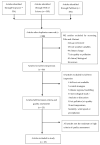Weather Variability and COVID-19 Transmission: A Review of Recent Research
- PMID: 33419216
- PMCID: PMC7825623
- DOI: 10.3390/ijerph18020396
Weather Variability and COVID-19 Transmission: A Review of Recent Research
Abstract
Weather and climate play a significant role in infectious disease transmission, through changes to transmission dynamics, host susceptibility and virus survival in the environment. Exploring the association of weather variables and COVID-19 transmission is vital in understanding the potential for seasonality and future outbreaks and developing early warning systems. Previous research examined the effects of weather on COVID-19, but the findings appeared inconsistent. This review aims to summarize the currently available literature on the association between weather and COVID-19 incidence and provide possible suggestions for developing weather-based early warning system for COVID-19 transmission. Studies eligible for inclusion used ecological methods to evaluate associations between weather (i.e., temperature, humidity, wind speed and rainfall) and COVID-19 transmission. The review showed that temperature was reported as significant in the greatest number of studies, with COVID-19 incidence increasing as temperature decreased and the highest incidence reported in the temperature range of 0-17 °C. Humidity was also significantly associated with COVID-19 incidence, though the reported results were mixed, with studies reporting positive and negative correlation. A significant interaction between humidity and temperature was also reported. Wind speed and rainfall results were not consistent across studies. Weather variables including temperature and humidity can contribute to increased transmission of COVID-19, particularly in winter conditions through increased host susceptibility and viability of the virus. While there is less indication of an association with wind speed and rainfall, these may contribute to behavioral changes that decrease exposure and risk of infection. Understanding the implications of associations with weather variables and seasonal variations for monitoring and control of future outbreaks is essential for early warning systems.
Keywords: COVID-19; humidity; precipitation; seasonality; temperature; weather; wind speed.
Conflict of interest statement
The authors declare no conflict of interest.
Figures




Similar articles
-
Relationship between COVID-19 and weather: Case study in a tropical country.Int J Hyg Environ Health. 2020 Aug;229:113587. doi: 10.1016/j.ijheh.2020.113587. Epub 2020 Jun 19. Int J Hyg Environ Health. 2020. PMID: 32917371 Free PMC article.
-
A review of the impact of weather and climate variables to COVID-19: In the absence of public health measures high temperatures cannot probably mitigate outbreaks.Sci Total Environ. 2021 May 10;768:144578. doi: 10.1016/j.scitotenv.2020.144578. Epub 2020 Dec 27. Sci Total Environ. 2021. PMID: 33450689 Free PMC article. Review.
-
Higher Temperatures, Higher Solar Radiation, and Less Humidity Is Associated With Poor Clinical and Laboratory Outcomes in COVID-19 Patients.Front Public Health. 2021 Mar 19;9:618828. doi: 10.3389/fpubh.2021.618828. eCollection 2021. Front Public Health. 2021. PMID: 33816417 Free PMC article.
-
Identification of weather variables sensitive to dysentery in disease-affected county of China.Sci Total Environ. 2017 Jan 1;575:956-962. doi: 10.1016/j.scitotenv.2016.09.153. Epub 2016 Oct 12. Sci Total Environ. 2017. PMID: 27742060
-
A systematic review and meta-analysis on correlation of weather with COVID-19.Sci Rep. 2021 May 24;11(1):10746. doi: 10.1038/s41598-021-90300-9. Sci Rep. 2021. PMID: 34031526 Free PMC article.
Cited by
-
Possible effects of air temperature on COVID-19 disease severity and transmission rates.J Med Virol. 2021 Sep;93(9):5358-5366. doi: 10.1002/jmv.27042. Epub 2021 May 3. J Med Virol. 2021. PMID: 33913555 Free PMC article.
-
Impact of climate indicators on the COVID-19 pandemic in Saudi Arabia.Environ Sci Pollut Res Int. 2022 Mar;29(14):20449-20462. doi: 10.1007/s11356-021-17305-9. Epub 2021 Nov 4. Environ Sci Pollut Res Int. 2022. PMID: 34735701 Free PMC article.
-
Leveraging weather data for forecasting cases-to-mortality rates due to COVID-19.Chaos Solitons Fractals. 2021 Nov;152:111340. doi: 10.1016/j.chaos.2021.111340. Epub 2021 Aug 18. Chaos Solitons Fractals. 2021. PMID: 34421230 Free PMC article.
-
The association of COVID-19 incidence with temperature, humidity, and UV radiation - A global multi-city analysis.Sci Total Environ. 2023 Jan 1;854:158636. doi: 10.1016/j.scitotenv.2022.158636. Epub 2022 Sep 7. Sci Total Environ. 2023. PMID: 36087670 Free PMC article.
-
Explaining the higher COVID-19 mortality rates among disproportionately Black counties: A decomposition analysis.SSM Popul Health. 2023 Jun;22:101360. doi: 10.1016/j.ssmph.2023.101360. Epub 2023 Feb 9. SSM Popul Health. 2023. PMID: 36785652 Free PMC article.
References
-
- Allam Z. Surveying the Covid-19 Pandemic and its Implications. Elsevier; Amsterdam, The Netherlands: 2020. The First 50° days of COVID-19: A Detailed Chronological Timeline and Extensive Review of Literature Documenting the Pandemic; pp. 1–7. - DOI
-
- World Health Organization Timeline of WHO’s Response to COVID-19. [(accessed on 10 October 2020)]; Available online: https://www.who.int/news/item/29-06-2020-covidtimeline.
Publication types
MeSH terms
LinkOut - more resources
Full Text Sources
Other Literature Sources
Medical

